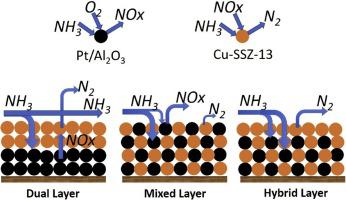Catalysis Today ( IF 5.3 ) Pub Date : 2020-01-13 , DOI: 10.1016/j.cattod.2020.01.017 Pritpal S. Dhillon , Michael P. Harold , Di Wang , Ashok Kumar , Saurabh Y. Joshi

|
The state-of-the-art Ammonia Slip Catalyst (ASC) has a dual-layer washcoat architecture with a bottom layer of Pt/Al2O3 and a top layer of Cu/SSZ-13. A trade-off between the NH3 conversion and N2 selectivity presents a challenge in the ASC design. While a sufficiently thick and active zeolitic top layer increases the N2 selectivity, it also imposes a diffusion barrier to the reacting species in reaching the bottom Pt layer, lowering NH3 conversion. Here we describe a systematic study to identify the ASC architecture and composition that optimizes the trade-off. The in-house synthesized ASC samples span the single layer Pt/Al2O3, conventional dual-layer Pt/Al2O3 + Cu/SSZ-13, uniform single layer of mixed Pt/Al2O3 + Cu/SSZ-13, and a hybrid design comprising a bottom layer of mixed Pt/Al2O3 + Cu/SSZ-13 and a thin top layer of Cu/SSZ-13. The overall Pt and Cu loadings are fixed across the series of samples with the Cu distributed between the two layers. The best results are obtained with the combination of a base mixed layer that provides for effective coupling between Pt and Cu active sites and a top Cu/SSZ-13 layer of an intermediate thickness and nominally half of the total Cu loading. This design has sufficient oxidation activity to convert the NH3 and reduction activity to limit NOx slippage. A 1 + 1 dimensional model which follows from our recent work [3] is effective in predicting most of the data and assists in converging on the best composition and architecture. The hybrid design exhibits a linearly decreasing dependence of the NH3 conversion and logarithmically increasing dependence of the N2 selectivity on the top layer Cu loading. The intersection of the two functions is shown to provide a good balance between the two opposing performance variables. The model is used to identify the combination of Pt loading and Cu loading distribution giving the maximum N2 yield for a specified temperature and space velocity.
中文翻译:

优化双层Pt / Al 2 O 3 + Cu / SSZ-13修补基面单块:NH 3选择性氧化为N 2
最先进的氨滑爽催化剂(ASC)具有双层修补基面涂层结构,其底层为Pt / Al 2 O 3且顶层为Cu / SSZ-13。NH 3转化率和N 2选择性之间的权衡在ASC设计中提出了挑战。尽管足够厚且具有活性的沸石顶层增加了N 2的选择性,但在到达底部Pt层时,它也对反应物质施加了扩散屏障,从而降低了NH 3转化率。在这里,我们描述了一项系统研究,以确定ASC架构和组成,可以优化权衡。内部合成的ASC样品跨越单层Pt / Al 2 O 3,传统的双层Pt / Al 2 O 3 + Cu / SSZ-13,均匀的混合Pt / Al 2 O 3 + Cu / SSZ-13单层以及包括混合Pt / Al 2底层的混合设计O 3 + Cu / SSZ-13和薄的顶层Cu / SSZ-13。Pt和Cu的总负载在一系列样品中固定,且Cu分布在两层之间。可以在Pt和Cu活性位点之间实现有效耦合的基础混合层与中等厚度且名义上占总Cu负载一半的顶层Cu / SSZ-13层的组合中获得最佳结果。该设计具有足够的氧化活性以转化NH 3和还原活性以限制NOx滑移。我们最近的工作[3]遵循的1 +1维模型可以有效地预测大多数数据,并有助于收敛于最佳构图和体系结构。混合设计表现出对NH 3转化的线性降低的依赖性,以及对顶层Cu负载的N 2选择性的对数线性增加。显示两个函数的交集可以在两个相对的性能变量之间提供良好的平衡。该模型用于识别Pt负载和Cu负载分布的组合,从而在指定的温度和空速下给出最大的N 2产量。


























 京公网安备 11010802027423号
京公网安备 11010802027423号